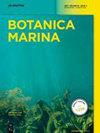Phaeosaccion multiseriatum(Phaeosacciaceae,Phaeosacciophyceae)的世界性地理分布,以及来自智利的 P. westermeieri sp.
IF 1.4
4区 生物学
Q2 MARINE & FRESHWATER BIOLOGY
引用次数: 0
摘要
最初由 P.J.L. Dangeard(nom. inval.它与最近从东北太平洋描述的 Phaeosaccion multiseriatum R.A. Andersen、L. Graf et H.S. Yoon 在遗传学上相似(99-100 % 的相同度),后者是一种昙花一现的藻类,地理分布广泛。我们还从韩国和福克兰群岛采集的底层样本中分离到了这种藻类,而在这些地方以前还没有报道过这种藻类。智利海岸的两个形态相似的分离物具有相同的核核糖体 SSU 序列,但在 psaA 和 psbC 序列上与新西兰的 P. multiseriatum 和 P. okellyi R.A. Andersen, L. Graf et H.S. Yoon 不同(遗传距离为 3-4 %)。这两个分离物被描述为 Phaeosaccion westermeieri sp.我们分离到的P. multiseriatum和P. westermeieri进一步证明了芽苗出现技术可以发现在野外容易被忽视的微小多细胞底栖藻类。本文章由计算机程序翻译,如有差异,请以英文原文为准。
Cosmopolitan geographic distribution of Phaeosaccion multiseriatum (Phaeosacciaceae, Phaeosacciophyceae), and description of P. westermeieri sp. nov. from Chile
The minute marine multicellular heterokont alga originally described as “Giraudyopsis stellifer ” by P.J.L. Dangeard, nom. inval. , from Atlantic France, was re-isolated by the germling emergence technique and classified according to psa A and psb C sequences. It is genetically similar (99–100 % identity) to Phaeosaccion multiseriatum R.A. Andersen, L. Graf et H.S. Yoon recently described from the NE Pacific, an ephemeral alga of wide geographical distribution. We isolated it also from substratum samples collected in Korea and the Falkland Islands, where it had not been reported previously. Two isolates of similar morphology from the coast of Chile had the same nuclear ribosomal SSU sequence but differed from P. multiseriatum and P. okellyi R.A. Andersen, L. Graf et H.S. Yoon from New Zealand in psa A and psb C sequences (3–4 % genetic distance). These two isolates are here described as Phaeosaccion westermeieri sp. nov.. Our isolations of P . multiseriatum and P. westermeieri are a further demonstration that the germling emergence technique can reveal microscopic multicellular benthic algae that are easily overlooked in the field.
求助全文
通过发布文献求助,成功后即可免费获取论文全文。
去求助
来源期刊

Botanica Marina
生物-海洋与淡水生物学
CiteScore
4.10
自引率
4.50%
发文量
43
期刊介绍:
Botanica Marina publishes high-quality contributions from all of the disciplines of marine botany at all levels of biological organisation from subcellular to ecosystem: chemistry and applications, genomics, physiology and ecology, phylogeny and biogeography. Research involving global or interdisciplinary interest is especially welcome. Applied science papers are appreciated, particularly when they illustrate the application of emerging conceptual issues or promote developing technologies. The journal invites state-of-the art reviews dealing with recent developments in marine botany.
 求助内容:
求助内容: 应助结果提醒方式:
应助结果提醒方式:


